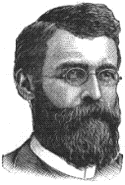John Patterson Rea facts for kids
Quick facts for kids
John Patterson Rea
|
|
|---|---|

Sketch of John Patterson Rea (1888)
|
|
| Born | October 13, 1840 |
| Died | May 28, 1900 (aged 59) |
| Education | AB, Ohio Wesleyan, 1864 |
| Occupation | Journalist and attorney |
| Signature | |
 |
|
John Patterson Rea (1840–1900) was an important person from Minnesota. He was a judge, a newspaper editor for the Minneapolis Tribune, and even led a big group of Civil War veterans called the Grand Army of the Republic. He was the Commander-in-Chief of this group from late 1887 to 1888.
Early Life and Family
John Patterson Rea was born on October 13, 1840, in Lower Oxford Township, Pennsylvania. He grew up in Chester County. He was a member of the Phi Kappa Psi Fraternity, just like his cousin John Andrew Rea. John P. Rea was a strong supporter of the Republican political party.
His family had a long history of serving the United States. His grandfather, Samuel Rea (1756–1816), fought in the American Revolutionary War. Samuel was a private in the Pennsylvania militia. He fought in important battles like Trenton, Princeton, and Brandywine. He also spent the winter at Valley Forge with General George Washington.
John's father, Samuel Andrew Rea, owned a woolen factory. John worked there when he was younger. He went to school until he was twenty years old. In 1860, he moved to Piqua, Ohio, where he worked as a teacher.
Civil War Service
When the American Civil War began, John P. Rea joined the Union Army. On April 17, 1861, he enlisted in Company B of the Eleventh Ohio Infantry. After four months, he became a second lieutenant in the First Ohio Cavalry.
He was promoted quickly because of his brave service. He became a first lieutenant in 1862 and a major in 1863. He served in the Army of the Cumberland for about three and a half years. He was only away from duty for ten days during this time. Seven of those days were spent as a prisoner of war. He had to leave the army in November 1864 due to poor health.
Life After the War
After the war, John Rea went to Ohio Wesleyan University. He graduated in June 1864. In 1866, he began studying law in Lancaster, Pennsylvania. He became a lawyer in August 1868. He worked with M. J. Dickey, who later became a member of the U.S. House of Representatives.
In 1869, President Ulysses S. Grant appointed Mr. Rea as an Assessor of Internal Revenue. He held this job until 1873. In 1869, he got married. John and his wife did not have children. However, he took a special interest in his cousin John Andrew Rea. They worked together to start the New York Alpha Chapter of the Phi Kappa Psi fraternity at Cornell University in 1869.
John Rea continued to practice law in Lancaster until December 1875. Then, he moved to Minneapolis, Minnesota. There, he became the editor-in-chief of a major newspaper, the Minneapolis Tribune. He worked as editor until May 1877, when he went back to practicing law.
In November 1877, he was elected Judge of Probate for Hennepin County, Minnesota. He served as a judge until December 31, 1881. Later, in April 1886, the governor appointed him to fill a vacant judge position in the local district court.
John Rea was also very active in the Grand Army of the Republic (GAR). This was a group for Union Army veterans. He was a founding member of GAR posts in Ohio and Pennsylvania. He later became the Commander of George N. Morgan Post No. 4 in Minnesota. He served as a leader in the Minnesota Department of the GAR. In 1887, he was elected Commander-in-Chief of the entire Grand Army of the Republic.
Death and Burial
John Patterson Rea passed away on May 28, 1900, in Nicollet Island, Minnesota. He is buried in the Little Britain Presbyterian Church cemetery in Pennsylvania. This cemetery is near where he was born.

